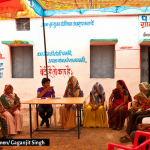
#2 What has changed for Centrally Sponsored Schemes (CSS) in 2015 – 16?
10 August 2016
In December 2013, my colleagues and I were about to embark on a new project in Bihar.
In April that year, the Government of Bihar had announced the launch of an ambitious, innovative scheme called Mission Gunvatta. The mission was aimed at improving learning levels in Bihar’s government primary schools. One critical intervention under the mission was the roll out of a Pratham led intervention called teaching at the right level (TARL). Under TARL, for two hours a day, schools would be organized according to student learning levels and taught using specifically designed materials.
The program, in its design was path breaking. For the first time a state government had chosen to explicitly commit itself to improving learning outcomes, at scale and chosen to move away from the prescribed curriculum to ensure that children would be able to improve their learning levels. The classes were to begin in July and run through the academic year. So when my colleagues and I arrived in the state to start our research work, we were expecting to find things moving full speed. To our surprise nothing had really moved. And when we dug deep we discovered that the Sarva Shiksha Abhiyaan(SSA), the Government of India’s (GoI), centrally sponsored scheme and key to the state’s education money (60% of the state’s budget is funded through the SSA) had not yet released money to the state education department to print the relevant materials.
The wait ended in late December when the state department found money through sources other than SSA to print text books but by then the school year was nearing completion and the mission never quite took off. This played havoc for our research project but more importantly, it offers an interesting insight in to the complex world of social policy funding in India.
Constitutionally, the bulk of what we can loosely define as social policy related programs lie within the domain of state governments. Ideally, money for these programs ought to be transferred through the finance commission directly to state governments, leaving state’s to determine their investment strategies. However, the fiscal transfer system also allows for specific purpose fiscal transfers through the center to states called Centrally Sponsored Schemes (CSS).
Over the years, and especially the last decade, CSS became rather popular. By 2012-13, fiscal transfers through CSS came to rival constitutionally designed routes, like grants under Article 275 or revenue sharing arrangements. In 2012-13, fiscal transfers through CSS and the Additional Central Assistance exceeded Rs 3,08,000 crore, while transfers through revenue share arrangements and grants in aid, amounted to Rs 3,66,000 crore.[1]
But there were many problems with this model. First, CSS were designed to privilege a top down, one-size fit all model where states were given relatively little flexibility in implementing programs. All budgets had to be negotiated with the center and if the center didn’t approve of what states where asking for, they went unfunded.
For instance, in education, a state government needed money to restructure its teacher-training model. To access SSA money, it had to seek GoI approvals through the state SSA authorities. GoI, however, refused to provide money because the re-structuring wasn’t aligned with the prescribed framework, leaving the state with no resources. Second, states had no authority to move funds across schemes. Thus if a state wanted to spend more money on health care over employment guarantee, it didn’t have the flexibility to draw on money received from the center to buttress its healthcare expenditures. Third, CSS mandated that state governments add a share of funds to the CSS from their plan budgets. This served to ring fence money available with states to finance programs as they saw fit. Finally, many of these CSS created a parallel implementation structure through specially created societies that were tasked with implementing the central program. And as funds to SSA increased, so did the power of these societies’. This served to create turf wars like we saw in Bihar between the SSA and state departments and in the end many good ideas never saw the light of day.
States were well aware of this problem and complained bitterly about the over-centralisation in India’s fiscal transfer system. It was to address this fundamental weakness in our financing system and realign the balance between constitutionally aligned functions and financial resources that the 14th Finance Commission increased the state share of tax devolution from 32% to 42% in 2015. [2]
So how have things changed? In her blog yesterday Avani highlighted the fiscal story pointing to the changes (and lack of changes) in CSS funding and its impact on state budgets. Avani suggests that the status quo is likely to be maintained, despite the efforts by the FFC to increase state autonomy.
I want to point readers to a possible explanation for this, based on my reading of the political economy of social policy financing. As I mentioned, over the last decade GoI rapidly expanded its role in financing key social programs through one-size fit all, tightly designed CSS. Implementing these schemes required the center to tightly control and monitor state budgets thus casting GoI officials in the role of headmaster’s wrapping states on the knuckles if they didn’t follow guidelines.
State’s on their part, while they disliked the centralised approach, saw in CSSs an important source of money which they aren’t happy to give up. This explains why almost every state politician and bureaucrat, having complained to the FFC about these schemes is now crying hoarse about the lack of funds, paying scant attention to the more pressing question of how best to use the untied funds. But CSS also played an important role in ring fencing money for social programs at the state level.
I have been surprised at how many state level politicians and bureaucrats have argued with me about the importance of CSS in ensuring social sector investments because of the proclivity to invest money in big-ticket infrastructure programs where the kickbacks are higher. Given this, there is some sense of comfort with the continued funding of social policy through CSS going forward.
But we do need to address the challenge of the one-size fit all model of CSS that state’s protested against in the first place. Watch out for my next blog on how I propose this can be achieved.





